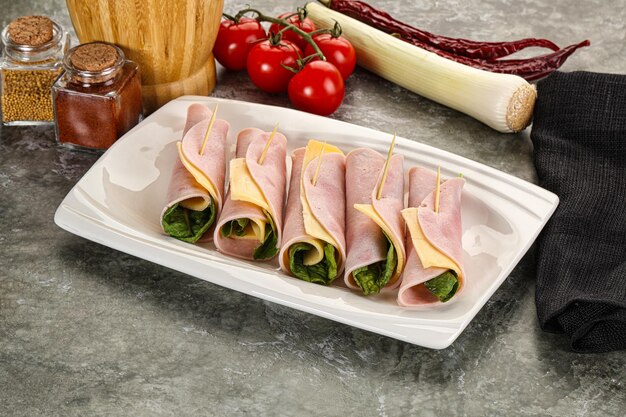How Long Does Cooked Ham Last in the Refrigerator? A Complete Guide
Are you wondering how long your leftover cooked ham will last in the refrigerator? Whether it's a festive occasion or just a regular grocery item, cooked ham is a delicious and versatile protein. Proper storage is key to maximizing its shelf life and ensuring it stays safe to eat. Here's a comprehensive guide to help you navigate through this food storage dilemma.
Understanding Cooked Ham Shelf Life
Cooked ham can last anywhere from 3 to 5 days in the refrigerator when stored correctly. This time frame is generally accepted and ensures that the ham remains both safe to eat and delicious. Factors like how fresh the ham was initially, how it was handled, and the storage conditions can all impact this duration.
Types of Cooked Ham
Understanding the type of ham you're storing can also determine how long it stays good in the fridge:
- Whole Cooked Ham: Typically lasts a bit longer due to fewer cut surfaces, sustaining freshness better.
- Sliced Ham: More surface area is exposed to air, possibly making it prone to quicker spoilage.
- Cured vs. Uncured Ham: Cured ham is treated with preservatives, which may extend its shelf life slightly compared to uncured ham.
Best Storage Practices for Cooked Ham
To maximize the freshness and safety of your cooked ham, follow these best practices:
Refrigeration Guidelines
- Immediate Refrigeration: Always refrigerate ham within two hours of cooking. If the room temperature exceeds 90°F (32°C), refrigerate within one hour.
- Sealed Containers: Store the ham in an airtight container or wrap it tightly with aluminum foil or plastic wrap to reduce exposure to air and contaminants.
- Fridge Location: Keep it on a lower shelf in the refrigerator, where temperatures are more stable, and away from raw foods to minimize the risk of cross-contamination.
Freezing Cooked Ham
If you don't plan to consume the ham within the recommended refrigeration period, freezing can extend its shelf life significantly. Frozen cooked ham can last up to two months for best quality. Here's how to freeze it properly:
- Portion Before Freezing: Divide the ham into individual portions or slices for easier defrosting and usage.
- Double Wrap: Use both plastic wrap and a freezer bag to prevent freezer burn and preserve moisture.
- Label: Always label the package with the date to keep track of its shelf life.
Signs That Cooked Ham Has Gone Bad
Before consuming leftover ham, it's crucial to inspect it for signs of spoilage. Here are a few red flags to watch out for:
- Unpleasant Odor: A sour or off smell indicates spoilage.
- Change in Color: Discoloration such as a grey or greenish hue is a bad sign.
- Slimy Texture: If the ham feels sticky or slimy, it's best to discard it.
Safe Consumption and Usage Ideas
Assuming your cooked ham passes the spoilage check, it's time to relish it in varied ways. Here are some ideas for enjoying your leftover ham:
- Ham Sandwiches: A classic use that's quick and easy.
- Ham and Cheese Omelet: Add it to your morning omelet for a protein boost.
- Salads and Soups: Diced ham can enrich a bowl of salad or soup.
- Baked Dishes: Consider incorporating it into casseroles or pasta bakes for added flavor.
Quick Tips for Safe Ham Storage 🍖
Here's your quick reference guide for storing cooked ham safely and effectively:
- 📅 Time Limit: 3 to 5 days in the fridge, up to 2 months in the freezer.
- 🌡️ Temperature: Store below 40°F (4°C) in the refrigerator.
- 🛡️ Packaging: Use airtight containers or double-wrap for freezing.
- 🚫 Spoilage Signs: Sour smell, color change, or slimy texture.
Related Considerations: Ham Safety and Environment
Food Safety Basics
Practicing regular food safety measures can considerably reduce the risk of foodborne illnesses:
- Use separate knives and chopping boards for raw and cooked foods.
- Always wash your hands before and after handling meat.
- Reheat leftover ham to at least 165°F (74°C) before consuming.
Sustainability and Waste Reduction
Wasting food is a significant global issue. Here’s how you can mitigate it:
- Plan Meals: Only cook what you expect to use within the week.
- Creative Cooking: Utilize leftovers creatively to minimize wastage.
- Compost: If the ham does spoil, consider composting it, adhering to local guidelines.
Through attention to storage and consumption practices, you can enjoy your cooked ham in several delicious meals, contributing to both safety and sustainability efforts.
Understanding how long cooked ham can last in the refrigerator—coupled with knowing how to store it properly—can ensure your food remains safe and flavorful. From choosing airtight containers to keenly eyeing spoilage signs, a little knowledge can go a long way. Enjoy your ham creations with confidence and care!
